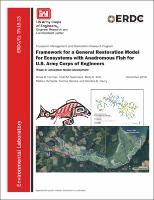Please use this identifier to cite or link to this item:
https://hdl.handle.net/11681/46645Full metadata record
| DC Field | Value | Language |
|---|---|---|
| dc.contributor.author | Herman, Brook D. | - |
| dc.contributor.author | Swannack, Todd M. | - |
| dc.contributor.author | Reif, Molly K. | - |
| dc.contributor.author | Richards, Nathan S. | - |
| dc.contributor.author | Barnes, Tomma | - |
| dc.contributor.author | Piercy, Candice D. | - |
| dc.creator | Environmental Laboratory (U.S.) | - |
| dc.date.accessioned | 2023-03-22T13:57:21Z | - |
| dc.date.available | 2023-03-22T13:57:21Z | - |
| dc.date.issued | 2018-12 | - |
| dc.identifier.govdoc | ERDC/EL TR-18-13 | - |
| dc.identifier.uri | https://hdl.handle.net/11681/46645 | - |
| dc.identifier.uri | http://dx.doi.org/10.21079/11681/46645 | - |
| dc.description | Technical Report | en_US |
| dc.description.abstract | Salmonid species are critically important ecologically, socially, and economically for North American coastal regions. Alterations to the structure (e.g., channelization) and function (e.g., sediment transport) of estuaries, rivers, and streams have greatly impacted these species, many are now listed as federally threatened or endangered. As part of environmental compliance procedures and policy, the U.S. Army Corps of Engineers (USACE) is required to assess the impacts and/or benefits of proposed water resource projects (e.g., levee maintenance, ecosystem restoration, etc.) to the environment. The USACE is required to predict and quantify environmental benefits using models to justify federal investment in ecosystem restoration projects. The purpose of this effort is to develop a general model or model framework that can be used during the USACE planning process that will serve as a unified standard Salmonid model. The primary purpose of the model will be to project future environmental benefits that will result from proposed restoration measures. Additionally, the model needs to be sensitive to different combinations of restoration measures in order to assist the USCAE in the planning and decision making process. This report presents the results of the first phase of model development using the mediated model development process. | en_US |
| dc.description.sponsorship | Ecosystem Management and Restoration Research Program (U.S.) | en_US |
| dc.description.sponsorship | United States. Army. Corps of Engineers. | - |
| dc.description.tableofcontents | Abstract .......................................................................................................................................................... ii Figures and Tables ........................................................................................................................................ iv Preface ............................................................................................................................................................. v Unit Conversion Factors .............................................................................................................................. vi Acronyms and Abbreviations .....................................................................................................................vii 1 Introduction ............................................................................................................................................ 1 1.1 Project background ......................................................................................................... 1 1.2 Purpose ........................................................................................................................... 2 1.3 Overview of previous USACE models ............................................................................. 2 2 Synthesis of Progress ........................................................................................................................... 6 2.1 Workshop purpose .......................................................................................................... 6 2.2 Workshop goals .............................................................................................................. 6 3 Model Parameters Discussed in Workshop ..................................................................................... 8 3.1 Model development ........................................................................................................ 8 3.2 Ecosystem drivers of environmental parameters ....................................................... 11 4 Workshop Recommendations .......................................................................................................... 14 4.1 Discussions and recommendations ............................................................................ 14 4.2 Workshop conclusion ................................................................................................... 16 5 Parameter Refinement ...................................................................................................................... 17 5.1 Evaluating parameters ................................................................................................. 17 5.2 Parameter recommendations ...................................................................................... 22 5.2.1 Structure ....................................................................................................................... 22 5.2.2 Connectivity .................................................................................................................. 27 5.2.3 Food .............................................................................................................................. 28 5.2.4 Landscape/edge cover ................................................................................................ 29 5.2.5 Refuge cover ................................................................................................................. 29 5.2.6 Predators ....................................................................................................................... 31 5.2.7 Substrate ....................................................................................................................... 32 5.2.8 Hydroperiod .................................................................................................................. 32 5.2.9 Water ............................................................................................................................. 33 5.3 Parameter refinement summary ................................................................................. 36 6 Conclusion ............................................................................................................................................ 38 References ................................................................................................................................................... 39 Report Documentation Page | - |
| dc.format.extent | 53 pages / 3.63 MB | - |
| dc.format.medium | PDF/A | - |
| dc.language.iso | en_US | en_US |
| dc.publisher | Engineer Research and Development Center (U.S.) | en_US |
| dc.relation.ispartofseries | Technical Report (Engineer Research and Development Center (U.S.)) ; no. ERDC/EL TR-18-13 | - |
| dc.rights | Approved for Public Release; Distribution is Unlimited | - |
| dc.source | This Digital Resource was created in Microsoft Word and Adobe Acrobat | - |
| dc.subject | Restoration ecology | en_US |
| dc.subject | Stream restoration | en_US |
| dc.subject | Environmental protection--Planning | en_US |
| dc.subject | Rivers--Regulation | en_US |
| dc.subject | Salmonidae--Mathematical models | en_US |
| dc.title | Framework for a general restoration model for ecosystems with anadromous fish for U.S. Army Corps of Engineers. Phase 1 : conceptual model development | en_US |
| dc.type | Report | en_US |
| Appears in Collections: | Technical Report | |
Files in This Item:
| File | Description | Size | Format | |
|---|---|---|---|---|
| ERDC-EL TR-18-13.pdf | 3.63 MB | Adobe PDF |  View/Open |